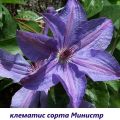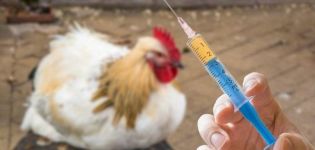Planting, growing and caring for clematis in the open field
A wonderful climbing plant like clematis needs proper planting and regular care. After all, it is difficult to grow a seedling, and if it is maintained incorrectly, it can be easily destroyed. It is better to buy varietal clematis with large flowers in a nursery, in the form of seedlings ready for planting. Usually it is a short bush with a well-developed root, which is immediately buried in a hole and watered. Perennial plants grow for a long time in the same place, however, it is advisable to warm them for the winter.
Content
- 1 Features of planting clematis
- 2 How to choose planting material?
- 3 Selection and preparation of the optimal landing site
- 4 Favorable landing time
- 5 The nuances of planting clematis seeds
- 6 Key points for caring for clematis after planting
- 7 How to help clematis grow
- 8 Diseases and pests to which clematis is susceptible
Features of planting clematis
Translated from the Greek "clematis" means a climbing plant. These beautiful flowers are grown to decorate garden arches, hedges, balconies, and house facades. In fact, clematis is a herbaceous perennial that belongs to the buttercup family. There are about 300 species of these plants, differing from each other.
Some varieties of clematis have lignified stems. In other plant species, young twigs grow back in the spring and die off in the fall. For the decoration of houses and household plots, shrub clematis from the group of lianas are grown, with long curly stems and small or large (more than 5 centimeters) flowers. Plants grow and rise thanks to special supports.
Clematis are planted with the help of seedlings grown independently from seeds or buy young seedlings (age - 1-2 years).
The sprouts purchased must have a healthy and developed root system, a stem from 5.5 to 20.5 centimeters high, on which there are buds. Before the onset of frost, the seedlings are planted in the selected area.
If there was no time to plant a bush in the fall, it is kept until spring in a cold room. The roots are sprinkled with slightly moist soil, with the addition of sawdust and sand, and the growing young shoots are constantly pinched. In the spring, the shrub is transplanted into its place, in a dug hole, and sprinkled with fertilized soil above the root collar.
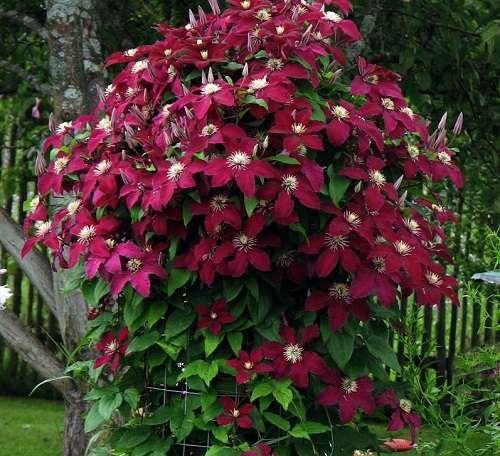
How to choose planting material?
There are many varieties of clematis. Planting material is bought depending on the region of residence and personal preferences.For the northern and western regions, early varieties are chosen (Victoria, Silver Stream), which bloom on twigs that have grown in spring and summer.
In the southern latitudes, varieties of clematis are planted (Florida, Lanuginoza), which bloom on the stems of the past and new years.
Clematis are divided into 3 groups. The first (A) includes plants that bloom on last year's branches. Group B includes shrubs that are capable of blooming on last year's and young stems. Group C plants bloom only on shoots grown in early spring or summer.
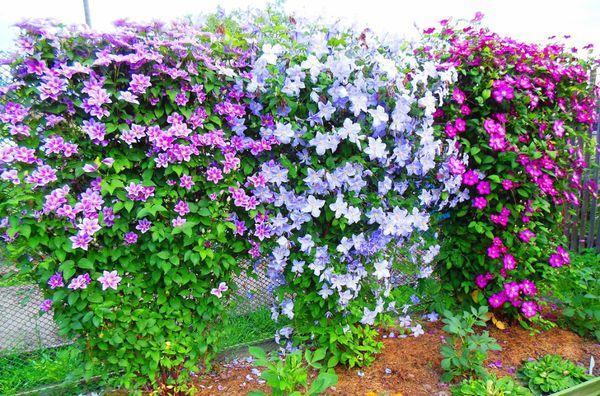
Group A includes the following varieties:
- alpine (Artagena Franchi, Albina Plena) - vines with a long stem (up to 3.5 meters) and with bluish flowers, blooming from May to August;
- flowery (Malysh, Zhanna d'Ark) - woody liana with a stem of more than 3 meters and large flowers of light shades;
- mountain (Rubens, Montana Grandiflora) - liana plant with a stem up to 9 meters, small leaves, medium-sized flowers of white, pink, red.
Group B and varieties:
- woolly (Madame le Cultre, Lavsonia) - a shrub plant with a stem 2.5-3 meters in length, large flowers of white, bluish, pinkish shades;
- sprawling (Multi Blue, Joan Picton) is a shrub with a stem up to 3 meters high, large flowers of white or dark blue shade (in spring and early summer it blooms on old twigs, in the second half of summer and in autumn it blooms on young stems).

Group C and varieties:
- Zhakmana (Rouge Cardinal, Star of India) - plant stems reach 3-6 meters, flowers of various shades, with a diameter of 8 to 20 centimeters, flowering falls in the second decade of summer;
- purple (Ville de Lyon, Viola) - clematis with a stem 3.5 meters in length, purple flowers from 12 to 22 centimeters in diameter, blooming from July to September;
- whole-leaved (Durana, Vyarava) - a shrub that does not cling to a support, with a low stem (up to 2 meters) and bell-shaped flowers of various shades, blooming from July to October.
Selection and preparation of the optimal landing site
Plants are usually planted in late spring or early fall. A young seedling bought in a container can be planted in any period (except for winter). Clematis are photophilous, their stems can break from strong winds, the bushes do not like sour and salty soil. In wetlands, plant roots rot.
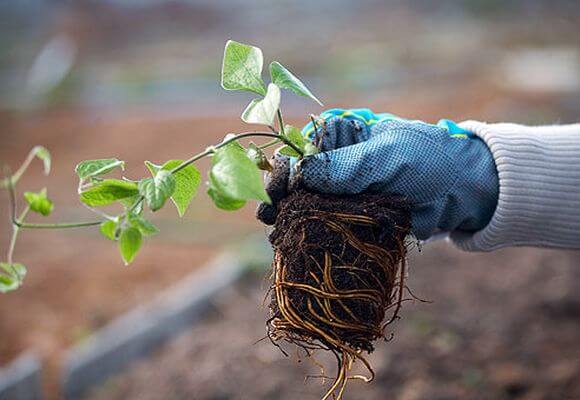
Where is it better to plant clematis on the site?
These plants love sunlight, so they don't bloom well in shaded areas. True, in the southern regions, it is advisable to plant clematis in partial shade so that the flowers do not suffer from heat and overheating. If several liana crops are planted on the site, then there should be a distance of up to one meter between adjacent stems.
It is advisable to plant clematis in places protected from drafts and winds. Too strong gusts of wind can break the fragile long stems of these plants. True, clematis grow reluctantly in the lowlands. Although these shrubs love abundant watering, they rot in wetlands. It is advisable to plant clematis near houses so that the water flowing from the roof does not heat their roots.
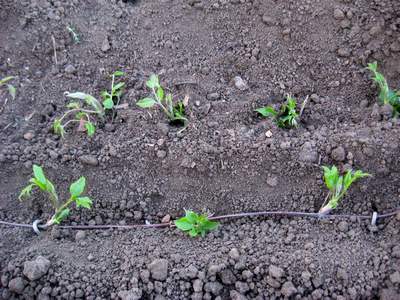
Preparing the soil and planting pit
The plant prefers soil rich in rotted humus and minerals (loam, sandy loam soil). The soil should have drainage, be loose, slightly acidic or slightly alkaline. In one place, these shrubs can grow for almost twenty years.
A small hole is dug for planting - 60-70 centimeters deep and wide. The dug soil is carefully cleaned of weeds, 5 kilograms of rotted humus, half a bucket of sand and peat, 200 grams of bone meal, 25 grams of superphosphate, potassium sulfate and ammonium nitrate are added to it.
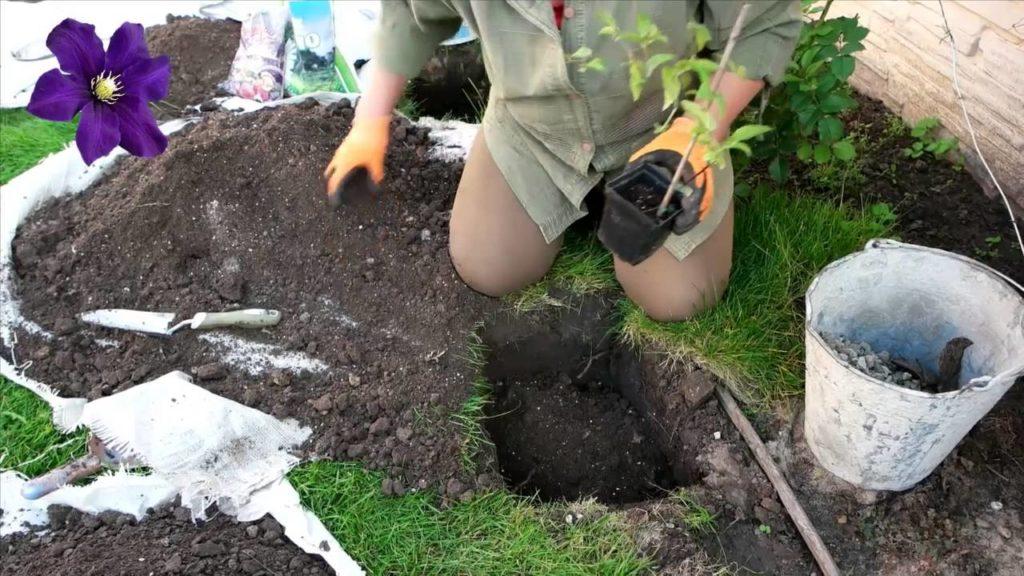
Clematis doesn't like too many nutrients.Fertilizers should be applied in small portions. If the soil is sour, add 200 grams of wood ash, lime or dolomite flour to it. Drainage (crushed stone, perlite) must be placed at the bottom of the planting hole.
How to prepare seedlings?
It is advisable to plant young annuals or biennials. The seedlings should be healthy, have roots ten centimeters long. There should be vegetative buds on the stem, and at least one shoot in spring planting. Before planting, the roots are immersed in a Heteroauxin solution for a couple of hours.
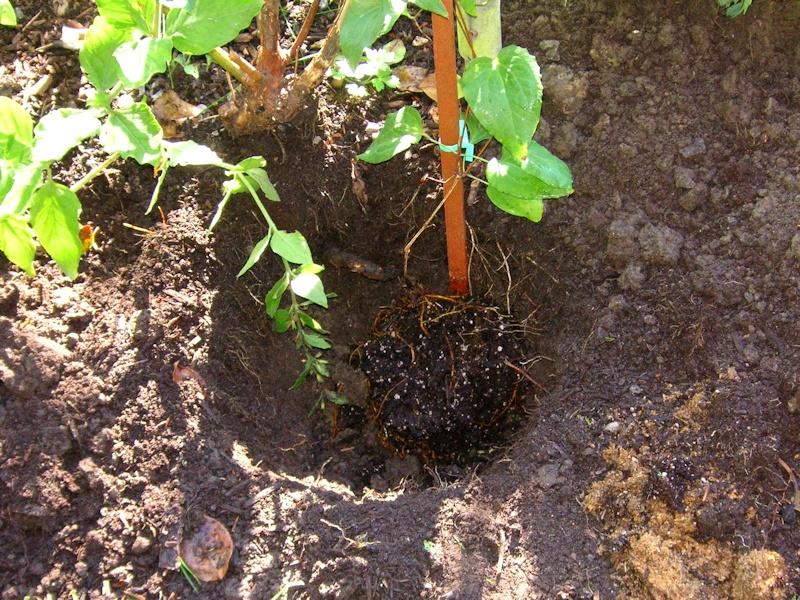
Favorable landing time
Clematis is planted, focusing on the climatic features of a particular region. In the spring, plants are planted in areas with a cold climate, because in the case of autumn planting, the seedlings may freeze in winter and not survive until next spring.
In the spring
Spring planting is carried out in northern latitudes. Clematis are planted from April to May. Before planting, a hole is prepared for the seedling, the soil is fertilized, the support is dug in. The root collar of a young seedling is dipped ten centimeters into the ground.
Summer
In the Middle Lane, seedlings can be planted in the summer. Plants are buried in a shallow hole, sprinkled with fertilized soil and watered with water. Usually summer planting is done by summer residents who did not have time to buy seedlings in the spring.

In autumn
Autumn planting is desirable for southern latitudes. Plants are planted from September to November. The seedling must have developed vegetative buds. Before planting, dig a hole and place the plant there. The roots are deeply covered with earth, from above the soil is mulched with dry grass or sawdust, lutrasil.
In the spring, the plant is opened, the excess soil is removed so that clematis can grow and develop normally.
Planting process
A rigid support is installed in the center of the fossa and sprinkled with earth. Then a plant is immersed on a mound made of earth and its roots are spread down on the sides. The basal main buds are sprinkled with soil by ten centimeters from above. Only in this way will the plant "bush". The older the seedling, the deeper it is immersed in the hole.
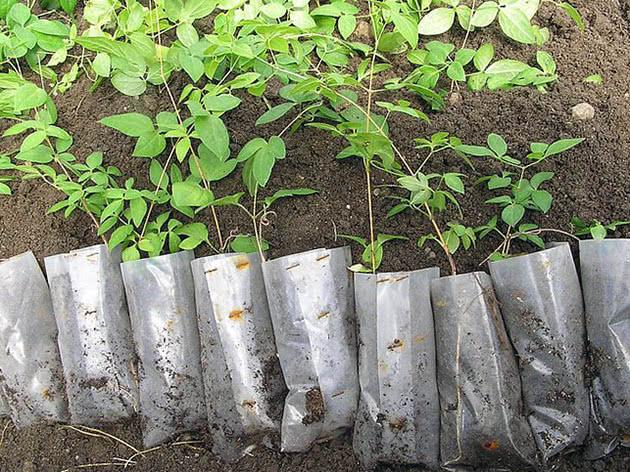
The root collar of adult bushes is buried by 18 centimeters. The lower buds should be well covered with earth. After planting, a bucket of water is poured under the root, and the earth around is mulched with peat or dry sawdust.
The nuances of planting clematis seeds
Clematis, if desired, is propagated by seeds. You can pre-grow seedlings, and in the spring, transfer them to the garden. Manchurian, Tangut variety, Clematis Helios are grown by seeds. Plants with large flowered seeds do not reproduce.
Some types of shrubs are planted immediately in the garden.
Directly into open ground
Clematis seeds are sown in spring on specially fertilized soil. Then the ground is watered with water. Before sowing, the seeds are soaked in a growth stimulator. The first shoots are born after 3 months. All this time, the land where the seeds are sown must be irrigated regularly and make sure that the soil does not dry out.
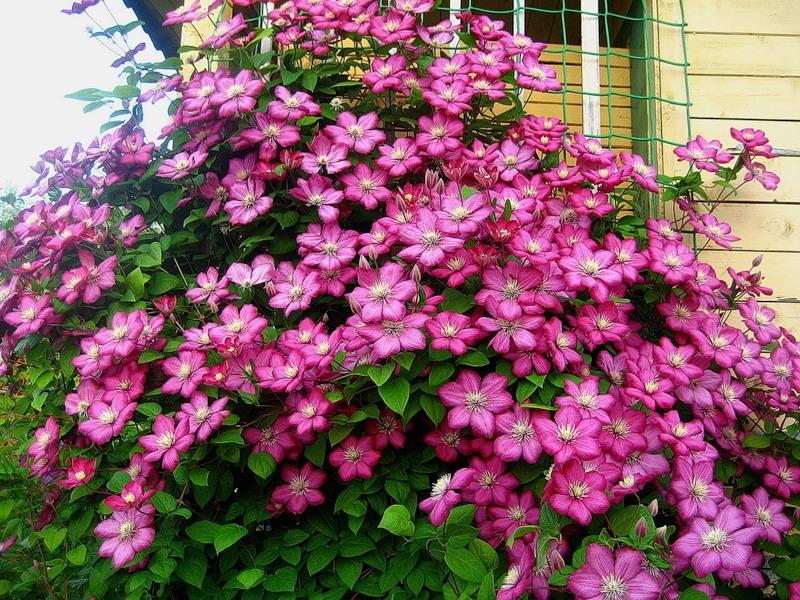
Seedlings
Seeds for seedlings, depending on the selected variety, are sown from December to March. The seed is coarse, medium and small. Large seeds germinate from 1.5 to 8 (or more) months. These include clematis of Jacqueman, Duran. Seeds of medium size "break through" for 1.5 to 6 months (Chinese, Manchu, six-petal). Plants with small seeds germinate in 2 weeks, maximum - in 4 months (Tangut, grape-leaved).
The best seedlings are those harvested this year. Such seed has a shelf life of 4 years (when stored in paper bags at room temperature). Large seeds are sown immediately after harvest at the very beginning of winter. Average - after the new year (in February). Small seeds - in March (until April).
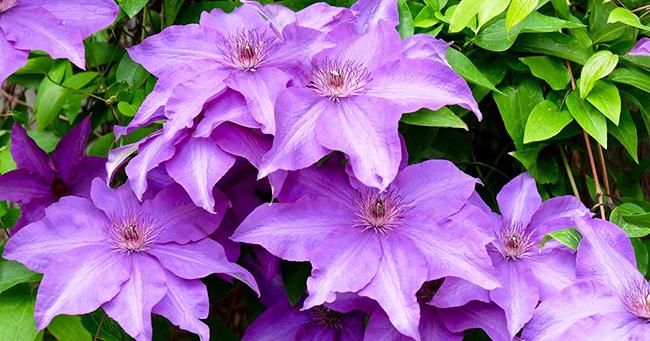
To accelerate growth, the seeds are soaked in a stimulating solution for a day before planting.For growing seedlings, shallow plastic or wooden boxes, clay pots are suitable. Prepared soil mixture is poured into the washed containers, consisting of garden, leafy soil, peat, sand and various mineral additives (potassium, nitrogen, phosphorus). Seeds are sown in shallow moist grooves, sprinkled with earth, slightly moistened and covered with foil or glass.
The room itself should be 22 degrees Celsius. While the seeds are sitting in the ground, the soil should be lightly irrigated with water.
When seedlings emerge, they are provided with sufficient lighting. Daylight hours should last about 12 hours. When the seedlings have two leaves, they dive, that is, they are transplanted from one container to another. In separate cups, seedlings grow until the night frosts subside, and the air outside warms up to 10 degrees Celsius. In mid-May, the seedlings that have grown over the winter are transferred to a permanent place.
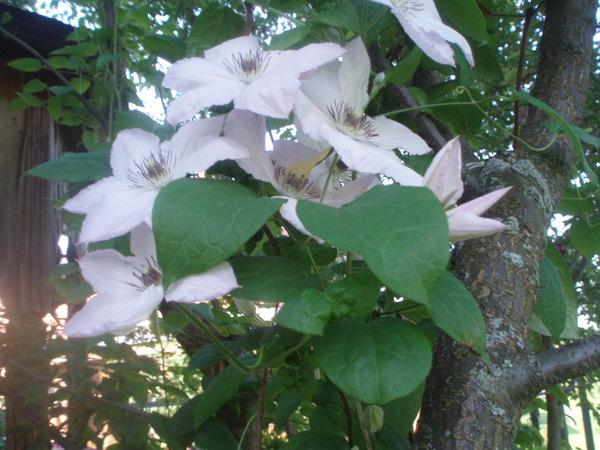
Key points for caring for clematis after planting
With proper care, clematis grows in the chosen direction and blooms profusely. Even at the time of planting, you need to trim. One or two main shoots are left on the stem, coming from the bottom. When the plant begins to grow, some of the branches are pruned. Regulatory pruning is done in summer. From time to time, the twigs are pinched.
Watering
At the very beginning of spring, the shrubs are poured with lime milk. In ten liters of water, 200 grams of lime are diluted. In hot weather, clematis is regularly poured with soft, settled water. Twice a week, from 10.5 to 20 liters of water is poured under the root of young bushes, the old ones need 30-40 liters of liquid at a time. If the summer is not very hot, the shrub is watered only once a week.
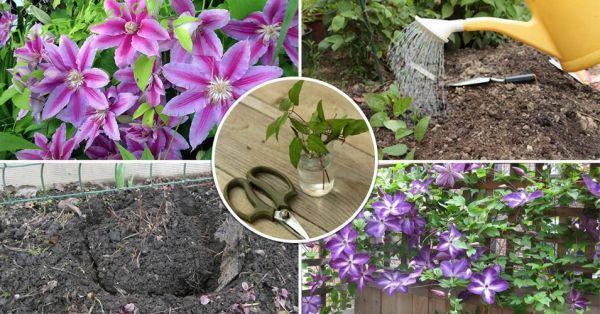
Support for clematis
For normal growth, development, long flowering, it is advisable to choose a support suitable for the vine. It must be strong and reliable to support the weight of the overgrown plants. You can use galvanized pipes, bamboo fences, various fences, wooden or metal gratings, nylon or iron mesh stretched over the frame.
Supports for flowers can be forsythia or weigela bushes. Traditionally, arches and screens are used for the growth of clematis. The supports themselves can be stationary or removable, that is, retractable for the winter.
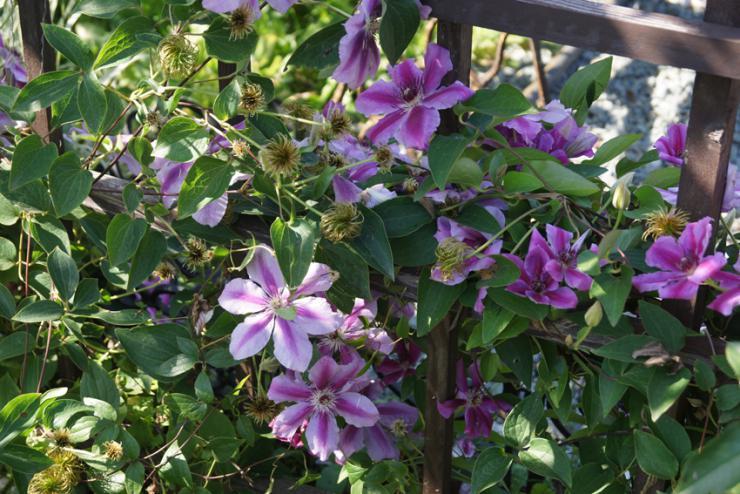
Loosening and mulching the soil
After rain or watering, it is advisable to loosen the land around the bush in order to destroy the soil crust and improve gas exchange. It is advisable to mulch the soil near clematis. Mulch retains moisture in the ground and inhibits the growth of weeds. The soil is usually mulched with peat, dry grass, and sawdust.
Weed removal
When loosening the soil, it is advisable to remove weeds. They take nutrients from the shrub. Weeds are pulled out of the ground without touching the clematis roots.
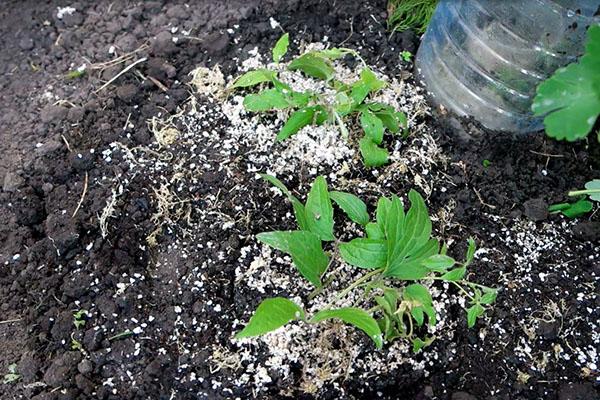
Reproduction
The plant is usually propagated by seeds or dividing the bush, layering, pinning young twigs. The division of the bush is carried out if the clematis is not more than 5 years old. An older plant is difficult to extract from the ground. A young bush is carefully dug up, then its roots are cleaned from the soil and divided into a couple of parts with a pruner. Each such particle should have shoots with buds.
Plants are laid in autumn. The leaves are removed from the young twig, bend it down, sprinkle it with earth, leaving only the top. For the winter, the stalk is covered with peat, sand, dry bark, sawdust. In the spring, all the mulch is removed, and the layers are watered with water with fertilizers diluted in it. By autumn, the young plant will have time to grow up, take root. It can be cut off from the mother's clematis and transferred to a permanent place.

In the spring, it is advisable to use the pinning method. Last year's twigs are pinned at the site of the knot into pots dug in next to them, in which the earth is poured.Such containers are slightly buried in the soil so that during watering the water flows to the roots. As the seedlings develop and grow, they are sprinkled with earth. By the fall, the seedlings grow up, then they are transferred to a permanent place.
Fertilization
Shrubs are fertilized 3-4 times per season. Fertilizers are applied after watering. It is advisable to alternate mineral and organic dressings. An interval of 2-3 weeks is maintained between fertilization. In the spring, clematis is fertilized with chicken droppings or rotted mullein dissolved in water. Instead of organic matter, the bush can be poured with a urea solution (25 grams per ten liters of water).
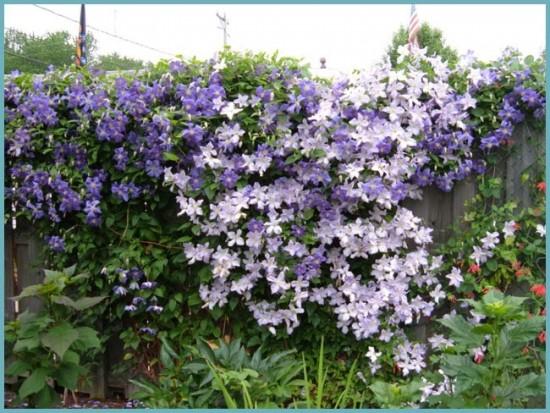
Before flowering, the plant is fertilized with superphosphate and potassium sulfate (15 grams per five liters of water). When the flowers bloom, clematis is not fed. In the summer, once a month, the shrub is poured with a weak solution of boric acid or potassium permanganate (2 grams per ten liters). For feeding through the leaves, use fertilizers Aquarin or Flower solution.
It is not recommended to fertilize clematis in autumn. During this period, the vine prepares for wintering. At the end of September, the bush is sprinkled with earth mixed with sand, peat, wood ash, removed from the fence and insulated.
How to help clematis grow
In order for the vines to grow properly, their stems are guided in the spring and tied to a support. If this is not done, the overgrown shoots will intertwine or crawl in the other direction, they cannot be untangled. In summer, clematis stems twine around the supports on their own. True, some varieties need to be tied up all summer during their growth, since the plants themselves do not know how to twine.
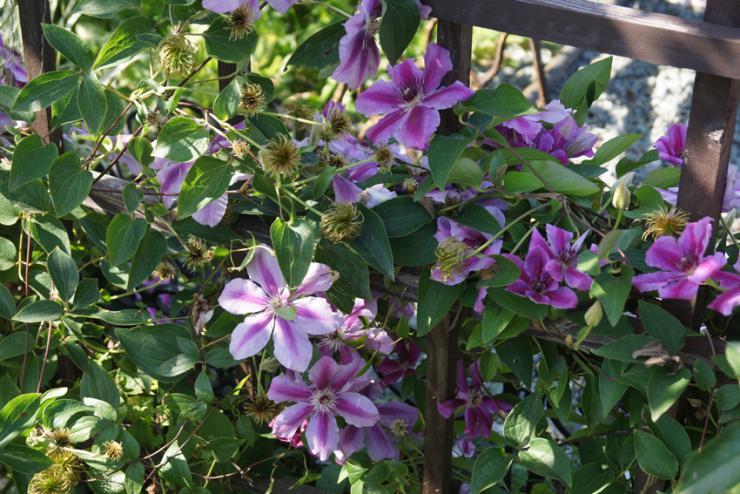
In order to improve flowering, clematis should be pruned regularly. In plants of group A and B, weak and dry shoots are cut in spring. After the end of flowering in the fall, cut off the upper part of last year's stems. In clematis from group C, before wintering, all young branches that have grown over the season are removed, leaving a low stump with several buds.
Diseases and pests to which clematis is susceptible
The plant can get sick and be attacked by insects. Pests of clematis: leaf and root nematodes. The plant is susceptible to such diseases: gray rot, powdery mildew, rust, verticillus wilting, ascochitis.
Clematis often suffers from wilting. The bush dries up, its leaves lose their elasticity, turn yellow and wither. The causative agents of the disease are fungi that live in the soil. In the spring, at the first signs of illness, a solution of Fundazol or Azocene is poured under the root. The same preparations are suitable for combating gray mold, powdery mildew. For rust, the leaves are sprayed with Bordeaux liquid or copper oxychloride. A solution of copper sulfate helps from ascochitis. For pest control, insecticides and nematicides are used (Fitoverm, Aktofit, Marshal, Alanicarb).
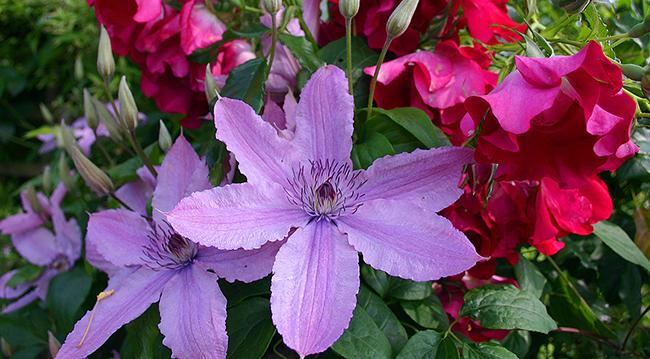
Preventive measures to protect clematis:
- every season the land around the plants is irrigated with a solution of copper sulfate;
- so that the soil is not acidic, it is watered with a solution of lime;
- before applying dressings, the bush is watered abundantly;
- to protect clematis roots from overheating, a lawn or low flowers are planted around it;
- during active growth, fungicides are used to combat fungal diseases (they are sprayed with leaves and flowers in the evening, in cloudy, but not rainy weather).
Before wintering, it is advisable to insulate the plant so that it does not freeze and die. The stems are treated with a solution of copper sulphate, they are earthed high with earth with sand and ash. For the winter, diseased shoots of plants are cut off, the liana itself is removed from the support, folded and placed near the stem on the base. Top covered with dry twigs, spruce branches, then waterproof material. In the spring, the plant is opened and tied to a support.






